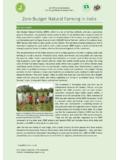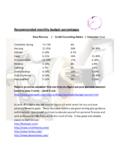Transcription of Wireless Link Budget Analysis
1 2010 Tranzeo Wireless Technologies. All rights and the Tranzeo logo are registered trademarks of Tranzeo Wireless Technologies other trademarks mentioned herein are the property of their respective Wireless Technologies Fraser Way, Pitt Meadows, BC, Canada V3Y 2V4 T: F: Toll Free: link Budget AnalysisHow to Calculate link Budget for Your Wireless NetworkRadio SystemsHow far can it go and what will the throughput be? These are thetwo commonquestions that come up when designing a high speed Wireless data link . There areseveral factors that may impact the performance of a radio system. Available andpermitted output power, available bandwidth, receiver sensitivity, antenna gains,radio technology, and environmental conditions are some ofthe major factors thatmay impact system performance.
2 For large scale network deployments, a detailed sitesurvey and network design are highly recommended. This paper will attempt toprovide the reader with an overview on how a link Budget is (LOS) link BudgetTo limit the scope of this paper, only line-of-sight links with sufficient Fresnel Zoneclearance will be considered. The following equation showsthe basic elements thatneed to considered when calculating a link Budget :Received Power (dBm) = Transmitted Power (dBm) + Gains (dB) Losses (dB)If the estimated received power is sufficiently large (typically relative to the receiversensitivity), thelink budgetis said to be sufficient for sending data under perfectconditions. The amount by which the received power exceeds receiver sensitivity iscalled thelink Path LossIn a line-of-sight radio system, losses are mainly due to free-space path loss (FSPL).
3 FSPL is proportional to the square of the distance between the transmitter andreceiver as well as the square of the frequency of the radio signal. In other words,free-space path loss increases significantly over distance and frequency. 10log Other losses in a radio system to consider are due to antenna cabling and connectors,which are already accounted for in Tranzeo s all-in-one units with integrated , for units with external antenna, loss per connector and lossfor every 3-ft of antenna cable should be included in the linkbudget calculations. Fora radio system with a 3-ft LMR400 cable and 2 connectors, loss should beincluded .The FSPL equation can be further simplified as follow: 20log 20log 20log 20log 20log , distance is measured in kmor milesand frequency in MHz, in this case the above equation becomes: 20log 20log 20log 20log 1 shows some calculated FSPL values for 900 MHz, , and (dB) 1: Free-Space Path Loss (FSPL)where:fis signal frequency in Hzdis distance in meters (m)cis the speed of light in a vacuum (3 x 108m/s)where dis in kmand fin MHzwhere dis in milesand fin MHz 2010 Tranzeo Wireless Technologies.
4 All rights and the Tranzeo logo are registered trademarks of Tranzeo Wireless Technologies other trademarks mentioned herein are the property of their respective Wireless Technologies Fraser Way, Pitt Meadows, BC, Canada V3Y 2V4 T: F: Toll Free: link Budget Analysis | How to Calculate link Budget for Your Wireless NetworkPAGE 2 Signal-to-Noise (SNR)Modulation techniques not only determine system bandwidthandchannel capacity, they also determine system s always atrade-off between data rates and distance. More efficient modulationtechniques such as 64-QAM require greater SNR, but less efficienttechniques such as BPSK require less SNR, and therefore are moreresilient to channel the purposes of link Budget Analysis , the most importantaspect of agiven modulation technique is the Signal-to-Noise Ratio (SNR)necessary for the receiver to achieve a specified level of reliability interms of Bit Error Rate (BER).
5 Table 2shows the minimum SNR required for the different modulationand encoding schemes. Site surveys should be conducted in alldeployment locations to ensure that sufficient SNR can be achieved tomeet the desired data and Fade MarginMultipath occurs when waves travel along different paths and causeunwanted interference with the waves travelling on the direct line-of-sight path. This is normally referred to as fading. A rare worst caseoccurs when waves travelling along different paths end up completelyout of phase and cancel each other. One way to overcome this problemis to transmit more power, or have enough link margin. In somecases,relocating or repositioning the antennas slightly may reduce theimpact of multipath.
6 Fading due to multipath can result in a signal reduction of more than30dB, and it s highly recommended that adequate link marginisfactored into the link Budget to overcome this loss when designing awireless 2: Data Rates vs. Minimum SNRWhy TranzeoTranzeo offers a complete family of ( )WiMAX products for , , and spectrumsincluding indoor and outdoor Subscriber Units and Pico BaseStations. As well, we offer a comprehensive line of 900 MHz, , , and and standards-based WiFi products including Routing Access Points, CPE s, Full-Duplex PtP Bridges, and advanced Mesh Routers and AccessPoints for complete turnkey Availability (%)Fade Margin (dB) & Encoding SchemeData Rate (Mbps)SNR(dB)BPSK 1/2 68 BPSK 3/499 QPSK 1/21211 QPSK 3/4 181316-QAM 1/2 241616-QAM 3/4 362064-QAM 2/3 482464-QAM 3/4 5425 Table 3: Rayleigh Fading ModelThe amount of extra RF power radiated to overcome this phenomenonis also referred to as fade margin.
7 The exact amount of fade marginrequired depends on the desired reliability of the link , buta good rule-of-thumb is to maintain 20dB to 30dB of fade margin at all 3shows the Rayleigh Fading Model, which highlights therelationship between the amount of available link margin and linkavailability as a percentage of time. 2010 Tranzeo Wireless Technologies. All rights and the Tranzeo logo are registered trademarks of Tranzeo Wireless Technologies other trademarks mentioned herein are the property of their respective Wireless Technologies Fraser Way, Pitt Meadows, BC, Canada V3Y 2V4 T: F: Toll Free: link Budget Analysis | How to Calculate link Budget for Your Wireless NetworkPAGE 3 Design ExampleWe ll use the TR-5plus-24 radio system as an example to illustrate how a link Budget is calculated using the information presented in this :Distance:5 Type:Point-to-Point (PxP)Line-of-Sight:YesRadio Systems:2 x TR-5plus-24 link Budget Analysis :First, we need to calculate the received power.
8 In order to dothat, we need to know the transmitter power and antenna gainsof the radio systemsthat we re using, which is normally documented in the datasheet of the radios and we re using 2 x TR-5plus-24, then the link Budget in both directions is expected to be symmetric. This is true because the transmit power ofboth radios is expected to be the same. In cases where 2 types of radio systems with different transmit power levels are used, then 2 link budgets,one for each direction, will need to be the TR-5plus-24 datasheet, the Tx power is +23dBm, and the internal antenna gain is24dBi. Since this product features an integratedantenna, we can assume negligible loss for cabling and this is a point-to-point link with sufficient FresnelZone clearance, then the only losses that we need to considerwhen calculating thereceived power is the free-space-path loss (FSPL).
9 The FSPLat 5 km is for as perTable 1. The received power can then becalculated as follow:Received Power (dBm) = Tx Power (dBm) + Tx Antenna Gain (dBi) +Rx Antenna Gain (dBi) FSPL (dB)= 23+24+24 required SNR to achieve 54 MBps data rate is 25dB, as perTable 3. Now that we know what the received power and the minimum SNR,wecould determine what the maximum channel noise is:Maximum Channel Noise (dBm) = Received Power (dBm) SNR (dB)= 25= , we need to ensure that we have enough link margin for a reliable link . The receive sensitivity of the TR-5plus-24 is -72dBm at 54 Mbps,which means that we have more than 20dB of link margin: link Margin (dB) = Received Power (dBm) - Receive Sensitivity (dBm)= (-72)= 5km, the link margin seems to be sufficient to provide 54 Mbps data rate and ensure better than 99% link availability based on Rayleigh s FadingModel shown inTable 3.
10 2010 Tranzeo Wireless Technologies. All rights and the Tranzeo logo are registered trademarks of Tranzeo Wireless Technologies other trademarks mentioned herein are the property of their respective Wireless Technologies Fraser Way, Pitt Meadows, BC, Canada V3Y 2V4 T: F: Toll Free: link Budget Analysis | How to Calculate link Budget for Your Wireless NetworkOnline ResourcesTranzeo Wireless Technologies Inc. - Wireless Network link Wireless Technologies Inc. Excel link Budget Tranzeo WirelessTMTranzeo Wireless Technologies Inc. (TSX:TZT) leads the Wireless broadband industry for value, by producing high-performance Wireless networkequipment with a low cost of ownership and unparalleled service allowing communities and businesses to communicate without boundaries.






